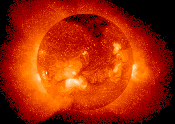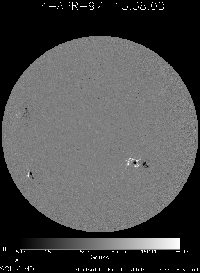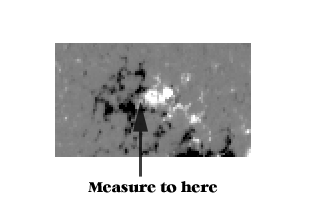About the Solar Images 

The SOHO images:
SOHO's instruments collect solar images in an assortment of formats. Some instruments look at the entire solar disk, others zero in on an interesting portion. Some block the Sun's brilliant glow with an eclipsing disk, allowing them to see the Sun's ethereal outer atmosphere, or corona. Some look at the Sun through wavelengths we cannot see with our eyes; these images are often strangely colored.
For the first activities, we are going to look at images collected by SOHO's MDI (Michelson-Doppler Imager) instrument. You can choose between 2 different types of images:
The Intensitygrams are nothing more than pictures of how bright the Sun is. Because sunspots are cooler than the surrounding regions, they will show up as black splotches.
- Regular, "white light" images called Intensitygrams
- Images of the Sun's magnetic field strengths -- called Magnetograms
The magnetograms, are pictorial representations of the Sun's magnetic field strengths and polarity. Active magnetic regions on the Sun will appear as white and black blotches. Quiet areas will be grey. Because sunspots are magnetic eruptions, they will be visible on magnetograms, appearing as large dark and light areas. (Not all the active regions are sunspots, but many of them are.) Each active region group will have a black portion and a white portion.
The images will look something like this, only larger:

(The real images will include a white square in the center of the Sun, which you should just ignore):

How Do I Choose Between Intensitygrams or Magnetograms?
The Intensitygrams show primarily sunspots. And the sunspots last longer than the active regions shown by the magnetograms. Sunspots can live up to 30+ days, but active regions generally hang around for only 5 or so days. (Often the active regions turn into sunspots, but sometimes they don't.)So, if you are doing the Sunspots Races activity, you should definitely use the Intensitygrams.
However, if you are doing the rotation activities, you could use either one. The magnetograms tend to have more "blotches" to track than the intensitygrams, and they are generally bigger. But the active regions are more short-lived than the sunspots on the intensitygrams. So, you can use either type.
Whatever type you choose, make sure you stay with that type throughout the entire activity. Do not use an intensitygram one day and a magnetogram the next!

Hints:
- To do the activities, you'll need to track the sunspots for about 2 weeks. Start with images for the current day. If these aren't complete, push the PREVIOUS DAY button and start with those. If you don't have 2 weeks to spare, you can use the images in the Examples.
- Each image indicates the time which it was taken (e.g.
SOHO MDI, Magnetogram, longi. comp., Full Disk (at 01:42) The "01:42" is the time. Each day when you retrieve your images, try to get one from the same time as the day before.
- Measure only the large blotches, and don't worry about the smaller dots or the spread-out areas which look like lace.
- When you measure the latitude and longitude of your sunspots, measure to the center of the spot group. On the magnetograms, measure to the area right between the white and black portions:


Return to "Retrieving Solar Images" Page

This page is https://solar-center.stanford.edu/solar_data/about-images.html
Created by Deborah Scherrer.
Last revised by DKS on Sept 12, 1997